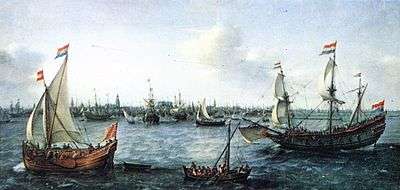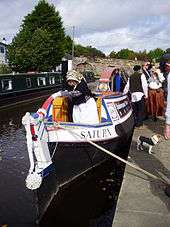Flyboat
The flyboat (also spelled fly-boat or fly boat) was a European light vessel (developed primarily as a mercantile cargo carrier, although many served as warships in an auxiliary role) of between 70 and 200 tons, used in the late 16th and early 17th century; the name was subsequently applied to a number of disparate vessels which achieved high speeds or endurance.
Origin
Richard the Lionheart developed a fleet of war galleys that was referred to as flyboats in the twelfth century. They were of Viking longship design made for speed and riverine warfare. They were tested in a port at Les Andelys under the protection of his new castle there. These boats were on the Seine River and from the towns of Portsmouth to Rouen.[1]
The name "flyboat" is also derived from Dutch vlieboot, a boat with a shallow enough draught to be able to navigate a shallow vlie or river estuary, such as the Vlie.[2] Armed flyboats were used by the naval forces of the Dutch rebels, the Watergeuzen, in the beginning of the Eighty Years' War. The type resembled a small carrack and had two or at most three masts, a high board and a dozen iron cannons. Small, inexpensive and manoeuvrable, it was ideal for privateering activities in the European coastal waters and soon imitated by privateers or pirates of other nations. The Dutch navy, and their enemies, the Dunkirkers, at first extensively employed flyboats. In 1588 the army of Alexander Farnese was blocked in Dunkirk by a fleet of thirty Dutch flyboats commanded by Lieutenant-Admiral Justin of Nassau, preventing him from joining the Spanish Armada to invade England.[3]

In the early 17th century the warship type became obsolete by the invention by the Dunkirkers of the frigate, then a small galleon type, although flyboats continued to be adapted in wartime for naval use until the 1670s. However civilian Dutch vlieboten continued to be built and evolved during the 18th century into much larger cromsters (kromstevens), then flat coastal cargo ships of up to 1200 tons. At the same time the term flyboat was used for a swift fishing vessel on the Atlantic. In the 19th century the term was used in England for canal boats, resembling small Dutch cromsters.
Fly-boats on the canals
An "express boat" service was started on the Glasgow, Paisley and Ardrossan Canal in 1830. One of their employees, William Houston, was guiding an empty horse-drawn boat when the horse took fright and bolted. Expecting the horse soon to tire, he hung on, but was amazed when the boat rose up onto its bow wave and shot off along the canal at high speed. Mr Houston was canny enough to realise the potential and soon travellers were being hauled along the canals at high speed in an early example of planing.[4]
This canal—11 miles without locks into the centre of Glasgow—was an ideal situation for this venture. It was found that once the boat was planing, the wash that damaged the canal banks largely disappeared and by 1835 flat iron boats of up to 65 feet made 323,290 passenger trips at 10 mph in a year. Services were established on the Forth and Clyde and on the Shropshire Union Canal flyboats with a single horse pulled 22 ton loads at 10 mph as late as 1847.[5][6] They were also called swift boats or gig boats.[7]

Occurring a year after the opening of the Liverpool and Manchester Railway, this development sparked enormous interest in the canal world. Books were published by Sir William Fairburn[8] and Sir John Benjamin Macneill.[9] The latter records experiments on the Paddington Canal in London attended by Thomas Telford and Charles Babbage. They hoped that steamboats running on the canals would be able to attain these high speeds and thus fight off the threat of the railways.
Unfortunately, a brilliant series of experiments conducted by the young John Scott Russell, for which he eventually received the gold medal of the Royal Society of Edinburgh and initiated research in solitons, demonstrated that the phenomenon could only be achieved in very shallow canals and that steamboats needed very different conditions.[10]
Flyboats pulled by one or more horses continued to be used in Britain and Ireland[11] for a number of years and even in America, but ultimately the railway proved the winner.
Canal carrying company fly-boat
A fly-boat is also a narrowboat which works all day and all night (24/7) on the English canal system without mooring.[12] They appeared in the 1790s and later attempted to emulate the railways by running to timetables so that deliveries could be assured.[13]
Notes
- ↑ McLynn 2012, p. 261.
- ↑ Unger, Richard W. (1973), "Dutch Ship Design in the Fifteenth and Sixteenth Centuries", Viator vol 4, p. 405
- ↑ Watergeuzen zijn uitstekende schutters
- ↑ Hazelwood, Dick (2005), A Brief History of Express Canal Boats (PDF), retrieved 25 May 2013
- ↑ Gladwin; White (1980), English Canals, Oakwood
- ↑ Hazelwood 2005
- ↑ Paget-Tomlinson 2008, p. 231
- ↑ Fairburn, William (1831). Remarks on Canal Navigation illustrative of the use of steam.
- ↑ Macneill, John Benjamin (1833), Canal navigation: on the resistance of water to the passage of boats upon canals, Roake and Varty, London]
- ↑ Russell, John Scott (1837), "Researches in Hydrodynamics" (PDF), Phil Trans RSE (printed 1840 ed.)
- ↑ Delaney, Ruth (2004), Ireland's Inland Waterways, Appletree Press, Belfast, pp. 137–9, 145–7
- ↑ Rolt, L.T.C. (1950), The Inland Waterways of England, George Allen and Unwin, p. 145
- ↑ Paget-Tomlinson, Edward (2008), The Illustrated History of Canal and River Navigations, Landmark Publishing, pp. 228, 248–9
Sources
- McLynn, Frank (2012). Lionheart and Lackland: King Richard, King John and the Wars of Conquest. Random House. ISBN 978-1-4464-4925-7.